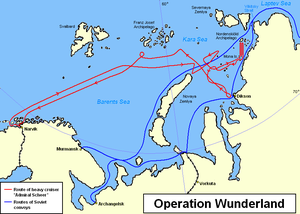Operation Wunderland
| Operation Wunderland | |||||||
|---|---|---|---|---|---|---|---|
| Part of the Arctic Theater of World War II | |||||||
 Map of Operation Wunderland |
|||||||
|
|||||||
| Belligerents | |||||||
|
|
|
||||||
| Commanders and leaders | |||||||
|
|
|
||||||
| Strength | |||||||
| 1 × heavy cruiser 3 × destroyers Several U-boats |
Weak units of the Soviet Northern Fleet |
||||||
| Casualties and losses | |||||||
| None |
Icebreaker Sibiryakov and five cargo ships sunk. Two cargo ships and two gunboats damaged. Shore installations damaged or destroyed at Dikson, Uyedineniya, Cape Zhelaniya and Khodovarikha |
||||||
Operation Wunderland (German: Unternehmen Wunderland) was a large-scale operation undertaken in summer 1942 by the Kriegsmarine in the waters of the Northern Sea Route close to the Arctic Ocean. The Germans knew that many ships of the Soviet Navy had sought refuge in the Kara Sea because of the protection that its ice pack provided during 10 months of the year. The naval operation to enter the Kara Sea during the summer thaw and destroy as many Russian vessels as possible was named "Operation Wunderland".
On 16 August 1942, Admiral Scheer — under Kommodore Wilhelm Meendsen-Bohlken — left Narvik and entered the Barents Sea. Along with it went U-boats U-601 (Captain Grau) and U-251 (Lt. Captain Timm), as well as destroyers Friedrich Eckoldt, Erich Steinbrinck and Richard Beitzen.
On 19 August, the German fleet rounded Cape Zhelaniya and entered the Kara Sea which was fairly free from ice during the short summer. The next day, the Arado Ar 196 seaplane on board Admiral Scheer flew to Kravkova Island in the Mona Islands and spotted three groups of Soviet ships there, with icebreakers Lenin and Krasin among them. Fog and ice floes, however, prevented the German warships from approaching. When they arrived at the Mona Islands, the Russian ships were gone. Then, Admiral Scheer turned northeast and sped towards the Nordenskiöld Archipelago.
...
Wikipedia
